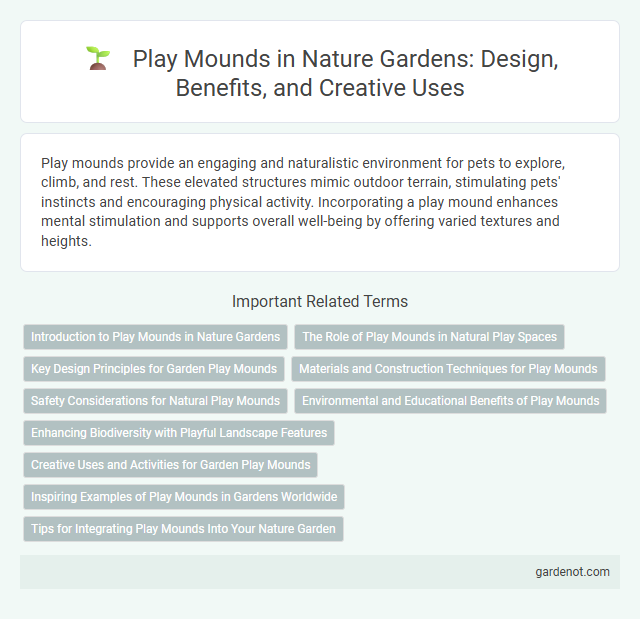Play mounds provide an engaging and naturalistic environment for pets to explore, climb, and rest. These elevated structures mimic outdoor terrain, stimulating pets' instincts and encouraging physical activity. Incorporating a play mound enhances mental stimulation and supports overall well-being by offering varied textures and heights.
Introduction to Play Mounds in Nature Gardens
Play mounds in nature gardens offer natural, elevated landscapes that encourage imaginative outdoor play and physical activity for children. These sculpted earthforms provide diverse sensory experiences through varied textures and plantings, fostering exploration and motor skill development. Integrating play mounds enhances biodiversity while creating engaging, eco-friendly spaces that connect kids with the natural environment.
The Role of Play Mounds in Natural Play Spaces
Play mounds serve as dynamic natural play elements that encourage physical activity, creativity, and exploration in children. These earthwork structures enhance spatial awareness and motor skills by providing varied terrain for climbing, running, and imaginative play. Integrating play mounds into natural play spaces fosters a connection to nature while supporting developmental benefits through unstructured outdoor experiences.
Key Design Principles for Garden Play Mounds
Garden play mounds should be designed with natural materials like soil, grass, and native plants to create an engaging and safe environment that encourages exploration and physical activity. Incorporating varied slopes, tunnels, and seating areas supports diverse play opportunities, from climbing and sliding to imaginative role-playing. Ensuring proper drainage, gentle inclines, and visibility for supervision enhances both usability and safety while fostering creativity and connection with nature.
Materials and Construction Techniques for Play Mounds
Play mounds are constructed using layered soils with a compacted core to ensure stability and durability, often incorporating locally sourced materials like clay, sand, and organic matter to blend naturally with the environment. Erosion control techniques such as geotextile fabrics and native vegetation planting are applied to maintain the mound's shape and safety over time. Incorporating textured surfaces and varied gradients enhances sensory experiences and promotes physical activity for children engaging with the play mound.
Safety Considerations for Natural Play Mounds
Natural play mounds designed with gentle slopes and soft, shock-absorbing surfaces reduce injury risks for children during active play. Incorporating erosion control measures like vegetation and textured ground coverings prevents surface degradation and maintains stable footing. Regular safety inspections ensure no hidden hazards such as sharp objects or unstable soil compromise the play environment's safety standards.
Environmental and Educational Benefits of Play Mounds
Play mounds enhance environmental quality by promoting natural erosion control and encouraging native vegetation growth, contributing to biodiversity. They provide dynamic, multi-sensory learning environments where children develop spatial awareness, motor skills, and problem-solving abilities through unstructured play. These naturalistic features foster environmental stewardship by connecting young learners to outdoor ecosystems and sustainable practices.
Enhancing Biodiversity with Playful Landscape Features
Play mounds integrate native plants and natural materials to create habitats that attract local wildlife, boosting biodiversity within play areas. These earthforms offer varied microhabitats supporting insects, birds, and small mammals, enriching ecosystem interactions. Incorporating uneven terrain and plant diversity encourages exploration while fostering ecological awareness among children.
Creative Uses and Activities for Garden Play Mounds
Garden play mounds stimulate imaginative play by serving as natural climbing structures, secret hideouts, or miniature hills for rolling and tumbling. Children can engage in role-playing games, such as pretending the mound is a castle or pirate ship, enhancing storytelling skills and social interaction. Incorporating sensory elements like textured surfaces, plants, or interactive features on the mound encourages exploration and creativity during outdoor play.
Inspiring Examples of Play Mounds in Gardens Worldwide
Play mounds, natural earth formations designed for climbing and imaginative play, are featured in renowned gardens such as the Queen Elizabeth Olympic Park in London and the Toronto Music Garden in Canada. These play mounds integrate organic shapes with native vegetation, encouraging active play and sensory exploration for children of all ages. Their innovative design balances safety, creativity, and environmental sustainability, making them exemplary models for nature-based play spaces worldwide.
Tips for Integrating Play Mounds Into Your Nature Garden
Incorporate natural materials such as soil, rocks, and native plants to blend play mounds seamlessly into your garden's ecosystem. Design varying slopes and textures to encourage physical activity and imaginative exploration for children. Position play mounds near shaded areas and pathways to ensure safety and easy supervision while maintaining aesthetic harmony.
Play Mound Infographic

 gardenot.com
gardenot.com